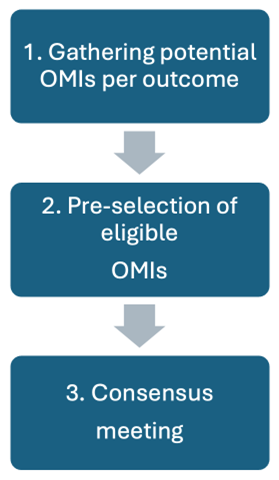The Core Outcome Sets have been defined
The COSs for feminizing and masculinizing gGAS are now complete and include 20 outcomes overall, including patient-reported outcomes, clinical outcomes and adverse events. These outcomes were developed through systematic literature reviews, qualitative interviews with transgender and gender-diverse individuals, a multi-round Delphi study, and a consensus meeting. The final sets will be published soon.
Measuring core outcomes
The next phase of the project focuses on determining:
How each outcome should be measured (selecting OMIs)
When each outcome should be assessed (timeline development)
Which information should be gathered with the measurement (additional reporting requirements)
A consensus process with clinical experts in the field is now undergoing to evaluate and refine those outcome measurement tools.
Update
Changes in survey round 3
To discover which outcomes are ‘core’ to participants, we made some adjustments to the setup of the survey in Round 2. Please see the previous update below on this webpage for a refresher. The results of Round 2 show that participants were able to prioritize, as some outcomes were rated so high that they met the threshold for recommended inclusion in the COS. Conversely, there were also outcomes that scored so low that they met the threshold for exclusion. These are removed from the shortlist of outcomes and are no longer in the race to become core. In Round 3, participants will be asked to rate only the outcomes for which no consensus was reached. For both the feminizing and masculinizing surveys, there were 19 such outcomes.
Table 1 describes the inclusion and exclusion thresholds that were upheld. Please see table 2 below for detailed information on these outcomes.
Table 1. Inclusion and exclusion criteria.
The survey of Round 3 will have the same setup as in Round 2. The only minor change that we made is that we have indicated which outcomes were rated considerably differently by the lived experience experts and the professional experts in Round 2. For these outcomes, we added a subsentence in the survey describing that we highly recommend participants read the accompanying quotes.
Table 2. Included and excluded outcomes.
Changes in Survey round 2
After the first survey round we analysed all the results and discussed our findings within the Study Steering Group. We came to the conclusion that minor modifications to the study protocol were needed in order to improve the study. The purpose of these modifications is to make the surveys more clear, shorter and easier to understand. To be fully transparent, we have summed them up below:
The study protocol states that in survey round 2, all outcomes are displayed with the average ratings of all stakeholder groups from the first survey round. Due to high ratings by all participants for all outcomes, the differences between the ratings of outcomes are unclear when displayed like that. To make this more clear, we made the following modification:
o The outcomes will be presented in the order in which they were rated in round 1, from the outcome with the highest score to the outcome with the lowest score.
In survey round 1 we asked all participants to rate outcomes on the level of importance on a scale of 1 to 5. Due to high ratings by all participants for all outcomes, we are not able to shorten the list of proposed outcomes. However, this needs to be done in order to make the Core Outcome Sets workable. To help participants prioritize, the phrasing of the question has been changed to:
o How much do you disagree or agree with the following statement: ‘This outcome should be one of the ten outcomes, that are always measured in research’. With the following scale: strongly disagree, disagree, neither disagree nor agree, agree, strongly agree.
Based on feedback on the length of the survey in round 1, we have made the following adjustments to shorten the second round survey:
o Provided reasons for the ratings in round 1 and more information can be displayed via a drop-down option.
o The explanation of the study and survey are offered in a short video. This will reduce the reading and will add visuals to enable easier understanding. You can watch the video below.
o Instead of showing all outcomes on multiple survey pages, we are now presenting all outcomes on one survey page. This will enable an easier overview.
In the Masculinizing Genital Gender-Affirming Outcomes surveys, the outcome ‘Mean urinary flow rate’ was proposed. Based on similar feedback from many participants, we've changed it to 'Maximum urinary flow rate' in this survey round. It was argued that this outcome was proven to be more relevant in earlier research.
In the first survey round experts by profession were asked whether they agreed with the stated definitions (formulated in medical-academic language) for all outcomes. Since the vast majority agreed with the stated definitions, these will not be questioned further in the next surveys. However, minor fine-tuning of the definitions, based on the provided feedback, will be done by the Study Steering Group at a later stage.
Survey explanation video of round 2:



